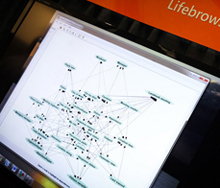Microsoft Builds a Browser for Your Past
Mining personal data to discover what people care about has become big business for companies such as Facebook and Google. Now a project from Microsoft Research is trying to bring that kind of data mining back home to help people explore their own piles of personal digital data.

Software called Lifebrowser processes photos, e-mails, Web browsing and search history, calendar events, and other documents stored on a person’s computer and identifies landmark events. Its timeline interface can explore, search, and discover those landmarks as a kind of memory aid.
“The motivation behind Lifebrowser is that we have too much stuff going on in our personal digital spheres,” says Eric Horvitz, the distinguished scientist at Microsoft who created Lifebrowser. “We were interested in making local machines private data-mining centers [that are] very smart about you and your memory so that you can better navigate through that great amount of content.”
Lifebrowser’s interactive timeline looks like a less polished version of Facebook’s recently introduced Timeline feature. However, Horvitz’s design predates Facebook’s and doesn’t rely on a user to manually curate it. Photos, e-mails, and other documents and data points appear in chronological order, but Lifebrowser’s timeline only shows those judged to be associated with “landmark” events by artificial intelligence algorithms. A user can slide a “volume control” to change how significant data has to be if it is to appear on the timeline. A search feature can pull up landmark events on a certain topic.
Horvitz, who has nearly 20 years of his personal data loaded into Lifebrowser, gave Technology Review a demonstration. For instance, searching for a person’s name made it possible to find the first e-mail that person had sent Horvitz, way back in 1997. Alongside it, Lifebrowser displayed photos from a significant family event that occurred at around the same time, aiding a fuller recollection of the period. “If I had to look at all of this, I would be overwhelmed, just as if all of my memories came rushing back,” Horvitz says.
Horvitz has given copies of the software to colleagues and friends and says they’ve had positive results. He is optimistic that the public will eventually get to try out Lifebrowser, but for now, it remains a research project.
Behind the scenes, Lifebrowser uses several machine-learning techniques to sift through personal data and determine what is important to its owner. When judging photos, Lifebrowser looks at properties of an image file for clues, including whether the file name was modified or the flash had fired. It even examines the contents of a photo using machine-vision algorithms to learn how many people were captured in the image and whether it was taken inside or outdoors. The “session” of photos taken at one time is also considered as a group, for cues such as how long an event was and how frequently photos were taken.
Lifebrowser looks for clues about whether a file is especially significant, and asks for extra hints if it’s unsure. A screen saver prompts a user to inform Lifebrowser if certain photos are of “landmark” events or not, and a simple dialogue does the same for calendar invitations. Over time, the system learns what’s important to you, and adapts. “You always think that machine learning is kind of cold,” says Horvitz. “This is showing that a model is not only learning about how I think, it’s also very warmly understanding what it means to capture humanity.”
Lifebrowser is impressive, says Sudheendra Hangal, a researcher at Stanford University who has built a tool called Muse (try it here) that helps people explore their e-mail archives with visualizations and other tools. Hangal has seen only a video of Horvitz’s software.
Hangal says trials of Muse have shown that most people are very interested in exploring their digital past if they have tools that make it easy. One popular use case is for people to find old e-mails and forward them to the original recipient to reminisce; another use is to look back and rediscover significant personal events.
Lifebrowser could let people do those things with more than just their e-mail, but Hangal suggests that systems like Lifebrowser and Muse could be most useful if they’re used to personalize other software and Web services. “Imagine if all the software on your machine could have access to this information,” says Hangal. “Because it reflects what you have done for many years, it offers very good personalization but is privacy-preserving.” That approach would be very different from the kind of data-mining-based personalization most common today, where companies such as Google or Facebook tailor content based upon the relatively short trail of personal data available to them.
Horvitz says he is considering how Lifebrowser’s knowledge could be used that way. “There’s a lot of possibility for data mining and personalization in the privacy of your own machine,” he says. “I would not feel comfortable sharing all this with a cloud service.”
Keep Reading
Most Popular
Large language models can do jaw-dropping things. But nobody knows exactly why.
And that's a problem. Figuring it out is one of the biggest scientific puzzles of our time and a crucial step towards controlling more powerful future models.
How scientists traced a mysterious covid case back to six toilets
When wastewater surveillance turns into a hunt for a single infected individual, the ethics get tricky.
The problem with plug-in hybrids? Their drivers.
Plug-in hybrids are often sold as a transition to EVs, but new data from Europe shows we’re still underestimating the emissions they produce.
Stay connected
Get the latest updates from
MIT Technology Review
Discover special offers, top stories, upcoming events, and more.